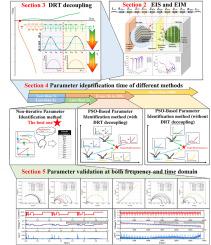基于电化学阻抗模型的锂离子电池多频动力学非迭代参数辨识
IF 7.9
2区 工程技术
Q1 CHEMISTRY, PHYSICAL
引用次数: 0
摘要
准确、高效的参数识别对于锂离子电池管理和检测应用至关重要,因为它可以实现精确的状态估计、故障诊断和质量评估。然而,传统的迭代识别方法计算时间长,而基于深度学习的方法需要大量的训练,这使得它们对于需要快速实时获取参数的应用来说不切实际。为了解决这些问题,本文提出了一种新的基于ei的非迭代参数识别方法,该方法使用简化的电化学阻抗模型直接将动力学参数映射到阻抗特性。通过消除迭代计算和训练开销,该方法在保持较高准确率的同时显著提高了识别速度。实验结果表明,该方法在负极和正极阻抗模拟中的相对平均绝对误差分别小于1%和6%。此外,将识别的参数应用于时域电化学模型仿真,验证了参数的一致性,高频自定义脉冲条件下的均方根误差为1.63 mV,动态应力测试条件下的均方根误差为34.07 mV。这些结果表明,该方法在电池管理系统中的实时电池状态估计和高效参数识别以及生产线中的快速质量评估方面具有强大的潜力。本文章由计算机程序翻译,如有差异,请以英文原文为准。

Non-iterative parameter identification for lithium-ion battery kinetics across multiple frequency ranges via electrochemical impedance model
Accurate and efficient parameter identification is essential for lithium-ion battery management and detection applications, as it enables precise state estimation, fault diagnosis, and quality assessment. However, conventional iterative identification methods suffer from long computation times, while deep learning-based approaches require extensive training, making them impractical for applications demanding rapid and real-time parameter acquisition. To address these challenges, this paper proposes a novel EIS-based non-iterative parameter identification method, which directly maps kinetic parameters to impedance characteristics using a simplified electrochemical impedance model. By eliminating iterative calculations and training overhead, the proposed method significantly improves identification speed while maintaining high accuracy. Experimental results show that it achieves a relative mean absolute error below 1 % and 6 % for negative and positive electrode impedance simulations, respectively. Furthermore, parameter consistency is validated by applying the identified parameters to time-domain electrochemical model simulations, yielding a root mean square error of 1.63 mV under high-frequency custom pulse conditions and 34.07 mV under dynamic stress test conditions. These results demonstrate the method's strong potential for real-time battery state estimation and efficient parameter identification in battery management systems, as well as rapid quality assessment in production lines.
求助全文
通过发布文献求助,成功后即可免费获取论文全文。
去求助
来源期刊

Journal of Power Sources
工程技术-电化学
CiteScore
16.40
自引率
6.50%
发文量
1249
审稿时长
36 days
期刊介绍:
The Journal of Power Sources is a publication catering to researchers and technologists interested in various aspects of the science, technology, and applications of electrochemical power sources. It covers original research and reviews on primary and secondary batteries, fuel cells, supercapacitors, and photo-electrochemical cells.
Topics considered include the research, development and applications of nanomaterials and novel componentry for these devices. Examples of applications of these electrochemical power sources include:
• Portable electronics
• Electric and Hybrid Electric Vehicles
• Uninterruptible Power Supply (UPS) systems
• Storage of renewable energy
• Satellites and deep space probes
• Boats and ships, drones and aircrafts
• Wearable energy storage systems
 求助内容:
求助内容: 应助结果提醒方式:
应助结果提醒方式:


